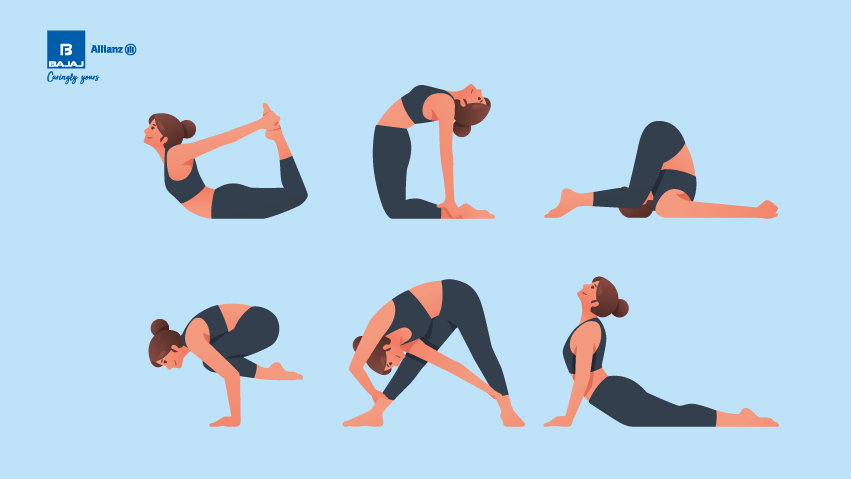With sedentary lifestyles becoming a norm, taking care of our health has never been more critical. Modern life, with its constant demands, often leads to physical and mental stress, which, if unchecked, can cause various health issues. While medical interventions and health insurance are essential, incorporating ancient practices like Halasana yoga pose into our daily routine can also be a powerful way to maintain overall well-being.
What is Halasana?
Halasana, also known as the Plow Pose, is a classic yoga pose that is highly regarded for its ability to stretch, strengthen, and rejuvenate the body. The term "Halasana" comes from the Sanskrit words "Hala," meaning plough, and "Asana," meaning pose. The pose mimics the shape of a traditional Indian plough, which symbolises hard work and cultivation, much like how Halasana cultivates health and vitality in our bodies.
Halasana Procedure
Performing Halasana involves a series of deliberate and mindful steps that help you achieve the pose safely and effectively. Here's a detailed halasana procedure to guide you:
1. Start in the Right Position
Begin by lying flat on your back on a yoga mat. Keep your arms by your sides, palms facing down.
2. Lift Your Legs
Slowly raise your legs towards the ceiling, keeping them straight without bending the knees. Hold this position as your legs form a 90-degree angle with your torso.
3. Move into the Plow Pose
Gently lift your hips off the floor, supporting your back with your hands. Continue to raise your legs over your head, aiming to touch the floor behind your head with your toes.
4. Hold the Position
Once your toes reach the floor, extend your arms along the floor behind your back, interlocking your fingers if possible. Ensure your legs remain straight and your spine is elongated.
5. Return to the Starting Position
To exit the pose, gently lower your back to the floor, vertebra by vertebra, while keeping your legs extended. Once your back is flat on the mat, lower your legs to the floor.
Ardha Halasana Yoga: A Variation
For beginners or those with specific health concerns, Ardha Halasana Yoga, or the Half Plough Pose, is a gentler variation. This pose involves raising the legs to a 90-degree angle and holding the position without moving the feet behind the head. Ardha Halasana offers many of the same halasana benefits as the full Halasana but with less strain on the neck and spine.
Benefits of Doing Halasana
The benefits of doing Halasana are vast, making it an invaluable addition to any yoga routine. Some of the key advantages include:
1. Enhanced Spine Flexibility
Halasana stretches the spine thoroughly, improving flexibility and relieving tension in the back. This can help alleviate chronic back pain and maintain a youthful, healthy spine.
2. Improved Digestive Health
By compressing the abdominal organs, Halasana stimulates digestion, helping to relieve issues like constipation and bloating. The increased circulation in the abdomen also promotes better organ function.
3. Stress Relief
The inverted nature of the Halasana yoga pose encourages blood flow to the brain, promoting relaxation and reducing stress. It’s an excellent pose for calming the mind and alleviating mental fatigue.
4. Strengthened Muscles
Halasana tones and strengthens the muscles of the back, shoulders, and legs, contributing to overall physical endurance and resilience.
5. Support for Weight Loss
While Halasana for weight loss might not be a direct solution, it plays a significant role in a weight management program by boosting metabolism, improving digestion, and reducing stress, which are all crucial for maintaining a healthy weight.
Precautions of Halasana
Despite its many benefits, Halasana should be approached with caution, especially for those with certain health conditions. Here are some key precautions of Halasana to keep in mind:
1. Avoid If You Have Neck Injuries
Halasana puts significant pressure on the neck, so it’s best avoided if you have any neck injuries or conditions like cervical spondylitis.
2. Consult a Doctor if You Have High Blood Pressure
Since Halasana is an inverted pose, it can affect blood pressure levels. If you suffer from high blood pressure, consult your doctor before attempting this pose.
3. Not Recommended During Pregnancy
Pregnant women should avoid Halasana due to the potential risks of compressing the abdomen and affecting circulation to the baby.
4. Menstruation Considerations
Women should avoid practising Halasana during menstruation as the inversion can disrupt the natural flow and cause discomfort.
Conclusion
Including Halasana in your yoga practice can significantly enhance your physical and mental well-being. However, like any exercise, it should be practised mindfully, with attention to proper form and personal limitations. By doing so, you can reap the benefits of doing Halasana while minimising any risks.
As we continue to tackle the challenges of modern life, it’s essential to combine traditional wellness practices like yoga with contemporary health solutions. You can start by getting a
health insurance plan from Bajaj Allianz General Insurance Company. This combination ensures that you are well-equipped to handle any health-related issues that may arise, providing peace of mind and a balanced approach to well-being. Whether you are seeking to improve flexibility, relieve stress, or support your weight management journey, Halasana offers a holistic way to enhance your health and vitality.
*Standard T&C Apply
**Disclaimer: The content on this page is generic and shared only for informational and explanatory purposes. It is based on several secondary sources on the internet and is subject to changes. Please consult an expert before making any related decisions.
***Insurance is the subject matter of solicitation. For more details on benefits, exclusions, limitations, terms, and conditions, please read the sales brochure/policy wording carefully before concluding a sale.
****The information presented is not meant to be a substitute for medical advice. Any suggestions mentioned should be considered for general use only. For expert guidance on any health ailment or medical issue or any treatment/procedure, please consult a certified medical professional.
 Service Chat: +91 75072 45858
Service Chat: +91 75072 45858


